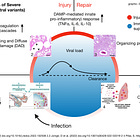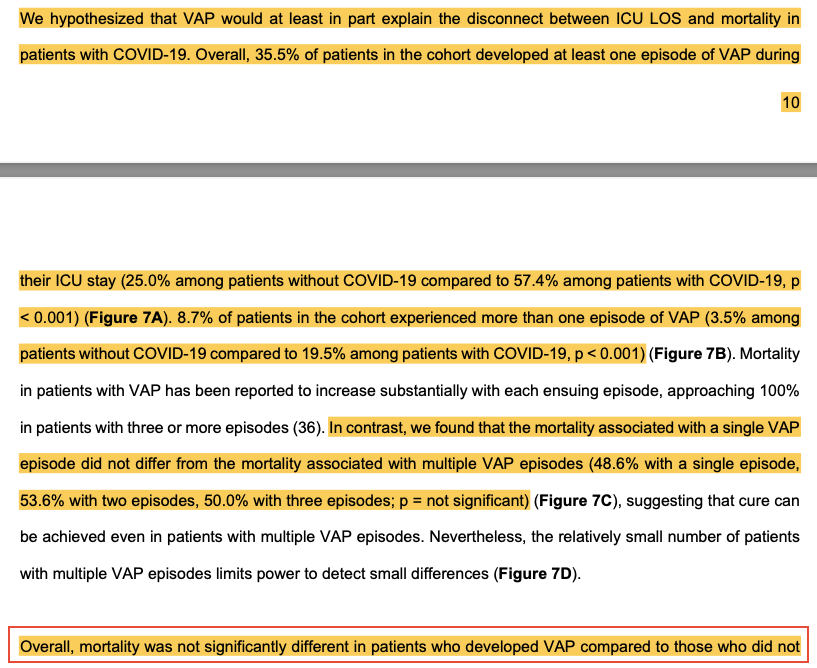The study has now been online for a few weeks, and may already be familiar to the reader:1
The text is dense and confusing — it is not immediately clear how the authors reach many of their conclusions — so this review was delayed.
Claimed study findings:
No support for “cytokine storm” (a condition that doesn’t even have a definition) as driving mortality in severe Covid-19.
Secondary pneumonia, namely unresolved ventilator-associated-pneumonia, is linked to mortality.
Plain-read study findings:
No support for “cytokine storm” (a condition that doesn’t even have a definition) as driving mortality in severe Covid-19.
Almost half of deaths in severe Covid-19 do not involve secondary infections. Nor does having a secondary infection greatly increase the rate of death, vs. not.
Prolonged respiratory stress drives long ICU stays.
The plain-read findings affirm my model for severe infection: Cytokine storm is not real; deaths occurred regardless of high use of antibiotics; the virus kills by directly injuring the lung:
The Set-Up
Gao, et al. feed clinical records from 585 ICU stays for severe pneumonia, 190 of with were from infection with SARS-CoV-2, into a machine that looks for patterns, called “CarpeDiem.”
The results: a clearer picture of a strangely little-known disease
The pattern “multi-organ failure,” as would be expected with the imaginary condition known as cytokine storm, does not feature in Covid-19 pneumonia patients. It isn’t happening. This should not be surprising, since as I reviewed in TASD pt. 1 (linked above), there was strong evidence of that fact three years ago; it has simply never been acknowledged.
Instead, patient-days for Covid-19 pneumonia are dominated by respiratory failure:
Indeed, CarpeDiem revealed that the long ICU LOS [length-of-stay] among patients with COVID-19 relative to patients with pneumonia secondary to other pathogens resulted from excess days in clinical states characterized by severe hypoxemic respiratory failure with significantly fewer transitions between states when normalized for their longer LOS. […]
CarpeDiem reveals that the long LOS among patients with COVID-19 is associated with prolonged stays in clinical states characterized by severe respiratory failure.
Both these quotes repeat the same finding. Why are Covid-19 patients staying in the ICU so long? Because they are in severe respiratory failure. Not cytokine storm.
But then why are they dying? Here is where Gao, et al. make some interesting choices in search of a seemingly pre-existing hypothesis that secondary infections drive death. They quote the now-famous study by Fauci, et al. regarding reexamination of pathological samples from 1918 flu deaths:
In a review of autopsy samples stored from the 1918 influenza A pandemic, Fauci and colleagues suggested an unexpectedly important contribution of secondary bacterial infection to mortality after severe viral pneumonia (17). Recent data suggest that secondary pneumonia is present in up to 40% and pneumonia or diffuse alveolar damage is present in over 90% of autopsy specimens obtained from patients with acute SARS-CoV-2 infection (18). Consistent with these observations, we and others found high rates of ventilator-associated pneumonia (VAP) in patients with SARS-CoV-2 pneumonia requiring mechanical ventilation, suggesting that bacterial superinfections such as VAP may contribute to mortality in patients with COVID-19 (7, 19–22). These findings prompt an alternative hypothesis that a relatively low mortality rate directly attributable to primary SARS-CoV-2 infection is offset by a greater risk of death attributable to unresolving VAP (23).
The alternative hypothesis is explicitly prompted by “these findings,” i.e. results from before this study. Yet the results in this study obviously reject the alternate hypothesis:
How many of the 190 ICU patients even develop ventilator-associated pneumonia?
57.4; just over half. The substantially higher rate vs. other pneumonias is in line with the observation already stated multiple times that Covid-19 patients spend more time in respiratory failure and in the ICU to begin with. It is a necessary reality of being in the ICU with a severe lung injury from an uncontrolled viral infection.
Is mortality different in those with and without ventilator-associated pneumonia?
Not much, and not in a statistically “significant” degree.
So the hypothesis, prompted by results from before this study, is not supported by the results from this study — the rate of death in those without ventilator-associated-pneumonia is “relatively lower,” but still almost just as high, as that without.
While a plain read of the results of this study support a simplistic model of severe Covid-19 as resulting from direct lung injury from the virus (as I have put forward), the “spin” the authors have chosen to place on their results is to hype up another too-clever-by-half account for deaths from severe infections. This spin has already been recycled in media reporting of the study:2
Secondary bacterial infection of the lung (pneumonia) was extremely common in patients with COVID-19, affecting almost half the patients who required support from mechanical ventilation. By applying machine learning to medical record data, scientists at Northwestern University Feinberg School of Medicine found that secondary bacterial pneumonia that does not resolve was a key driver of death in patients with COVID-19. It may even exceed death rates from the viral infection itself.
But a plain reading of the results only supports the tentative conclusion that ventilator-associated-pneumonia drives the difference in the rate of death vs. the “No VAP” group; and this difference is a small fraction of overall deaths in both groups.
Undeterred by such an obvious message from reality in their own results, Gao, et al. drill down into associations with unresolved VAP and mortality that are needlessly complex3 (of course “unresolved” pneumonia will lead to death) and prima facie incapable of altering the big picture of whether secondary infections are driving most deaths. They aren’t.
In conclusion
The new paper by Gao, et al. supports dumping both the myth of cytokine storm and unresolved secondary infections in in-hospital deaths. These result from severe lung injury and hypoxia induced by ventilation-perfusion mismatch, as proposed in TASD and the review of Archer, et al.
If you derived value from this post, please drop a few coins in your fact-barista’s tip jar.
Goa, CA. et al. “Machine learning links unresolving secondary pneumonia to mortality in patients with severe pneumonia, including COVID-19.” J Clin Invest. 2023 Apr 27;e170682.
“What really killed COVID-19 patients: It wasn't a cytokine storm, suggests study.” (2023, May 4.) medicalexpress.com
Hence, again, the length of time required to review the study, just to find that there is no support for their asserted findings.













Another take that seems more reasonable:
https://popularrationalism.substack.com/p/missed-bacterial-pneumonia-cases
I've seen a few other people covering this, and so I finally decided to look at the paper. Just as you stated, it seems entirely confusing how they got their results.
For instance, when considering VAP did they differentiate pneumonia from SARS-COV2 vs VAP? The methods suggest that at least 48 hours on a ventilator with bacterial culturing were used to suggest a VAP episode:
". By definition, VAP was considered to be an incident pneumonia that was diagnosed by a BAL performed after at least 48 hours of mechanical ventilation (39); only VAP episodes that were adjudicated to be due to bacteria were included in the analysis. "
They don't provide any evidence of what bacteria they cultured, and the study does not appear to use SARS-COV2 ICU patients without ventilation as a frame of reference (the 190 included appeared to have had SARS-COV2-related pneumonia, although one can argue that the design of SCRIPT would inherently focus only on pneumonia so this group should be assumed to not be included).
So I'm struggling to see how they were able to fully differentiate SARS-COV2 pneumonia from VAP, but I suppose that's an issue with any VAP study. They also don't indicate specific timepoints for when BAL samples were collected, just stating they did "serial collection".
I tried skimming through the supplemental section but it doesn't seem to indicate the number of BAL samples collected. This sentence in the methods makes it seem as if they only collected samples at the time of a suspected episode of pneumonia, but does that mean they continued to take samples throughout the course of the infection:
"ICU physicians at NMH routinely obtain bronchoscopic or non-bronchoscopic BAL samples
from mechanically ventilated patients whenever pneumonia is suspected (47)."
Given that all of the correlations made by their software are dependent upon the data they provide it, I would assume that there's an inherent bias in these results that should be taken into great account.
I think the last thing I noticed so far is that they never mentioned anything related to actual quantitation of cytokine profiles. Their limitations actually mentions that they did not quantitate any inflammatory biomarkers, but rather it appears that they are making assumptions about a "cytokine storm" with respect to the transitions into worse groups. This would seem like a non-answer for anything for or against the cytokine storm argument. It just looks like they didn't take any approach at all and are just making qualitative assumptions.
I haven't spent more time with this paper but it seems like so much was left up to how the AI interpreted the results that I can't help but consider this a fishing expedition.